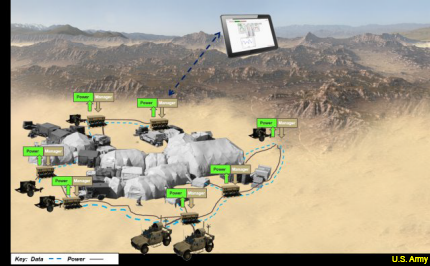Army pushing energy efficiency closer to the front
CERDEC demonstrates a base-camp microgrid that cuts down significantly on fuel use, water use and waster generation without compromising services.

The open-architecture EIO includes load-sharing features for generators.
The Army, which has put a lot of emphasis on renewable energy and reducing power consumption at its installations around the world, is also taking energy efficiency to its forward deployed bases. The service’s Communications-Electronics Research, Development and Engineering Center, or CERDEC, recently demonstrated its Energy Informed Operations (EIO) microgrid at Fort Leonard Wood, Mo.
The goals: Cut fuel resupply by 25 percent, water resupply by 75 percent, and waste generation for back haul by 50 percent without compromising services.
The effort is driven not just by the monetary and environmental costs of energy use—the Army wants renewable sources to account for 25 percent of its energy use by 2025, eliminating about 20 trillion BTUs of fossil-fuel sources and saving about $300 million a year—but also by the increasing power demands of the battlefield. The Army in recent years has moved a lot of technology to forward-deployed bases. That gives soldiers more capabilities and support, but it also requires more power in areas where it’s not readily available.
“Increased capabilities for the soldier have caused energy demands on the battlefield to increase,” Marnie Bailey, team lead for the project, said in a CERDEC news release. “Energy Informed Operations aims to provide the soldier the ability to interactively monitor and manage power systems in order to optimize power availability, allowing the unit to maintain mission critical systems needed to achieve mission success.”
In the demonstration, hosted by the Natick Soldier Research, Development and Engineering Center and the Maneuver Support Center of Excellence, the microgrid supported operations for a 24-hour period, both in barracks at night and in the field during daytime exercises. Built with an open architecture to allow for easy plug-and-play, it features nine new sets of technologies and non-materiel solutions.
A significant feature of the microgrid is its ability to adapt to changing demands, CERDEC said. During morning activities when demands approached 90 percent of the primary generator’s capacity, to give one example, the grid turned on a second generator and initiated a load-sharing process.
“This demonstration and assessment of new base camp technologies are very important for the Army and the joint warfighter,” said Maj. Gen. John F. Wharton, commanding general of the Army’s Research, Development and Engineering Command. “These nine technologies are critical to the objectives of reducing the fuel, water and waste water removal requirements of expeditionary base camps, which will reduce the need for re-supply and reduce the risk to our warfighters conducting re-supply operations."




